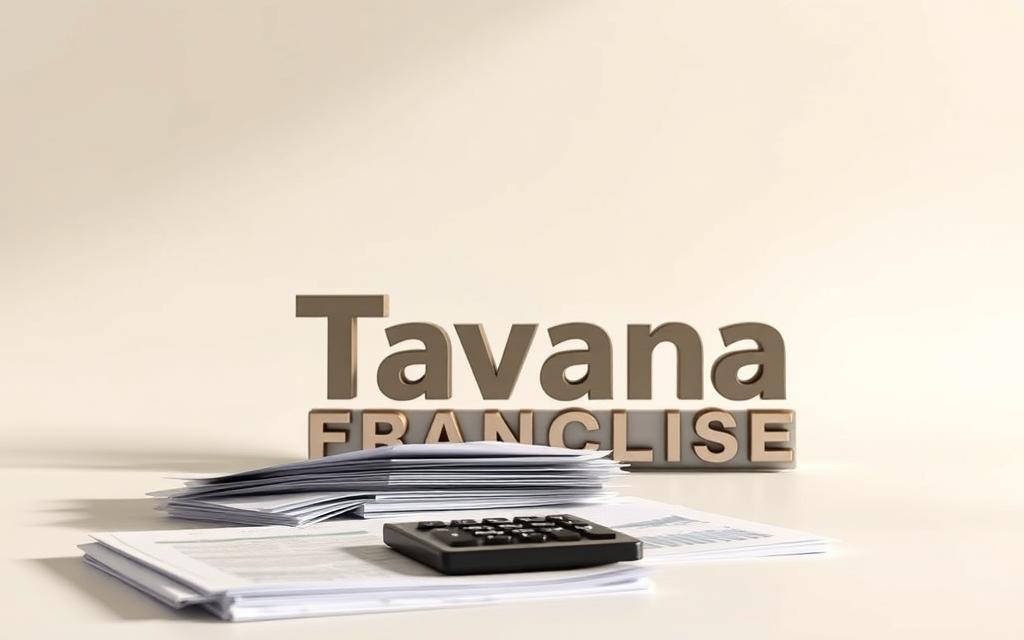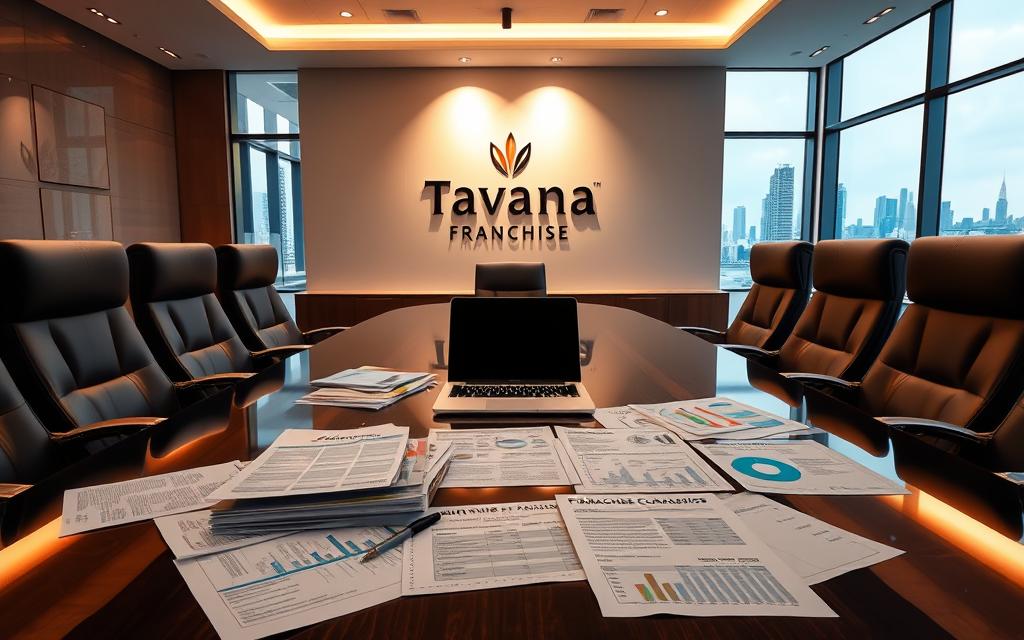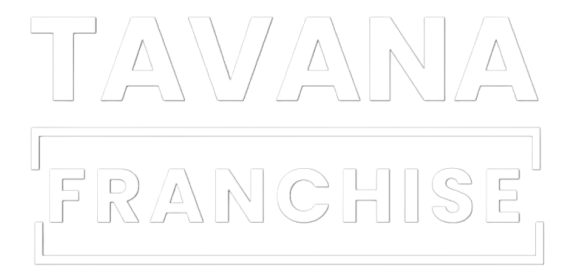Did you know that starting a franchise can cost between $50,000 and over $1 million? Knowing the investment needed is key before you decide.
Buying a franchise can be a smart move for entrepreneurs. It lets you run a business with the support of a well-known brand. But, it’s important to understand what you’ll need to start.
The costs include the initial fee, equipment, setting up a location, and the first batch of products. Knowing these expenses helps you make a smart choice about your investment.
Key Takeaways
- Understand the total investment needed for a franchise.
- Break down the components of the initial capital.
- Consider the various expenses involved in starting a franchise.
- Make an informed decision by understanding the full scope of the investment.
- Research the average initial investment for your desired franchise.
What is Franchise Cost?
Franchise costs include many expenses that new franchisees need to know. Investing in a franchise means more than just one fee. It involves various costs like startup fees, ongoing fees, and other financial duties.
Defining Franchise Costs
Franchise costs are the total money needed to start and keep a franchise running. These costs fall into several groups, like initial fees, startup costs, and ongoing expenses. Knowing these costs helps decide if a franchise is a good investment.
The initial franchise fee is a one-time payment to the franchisor for using their brand. This fee changes based on the franchisor, the business type, and support level.
Understanding Initial Investments
The average initial investment is the total money needed to start a franchise. It includes costs like franchise fees, equipment, and location changes. This investment can be big and changes a lot between franchises.
Some main parts of the initial investment are:
- Franchise fees: The initial fee paid to the franchisor.
- Equipment and supplies: The cost of buying or leasing needed equipment and initial stock.
- Location preparation: Costs for setting up or fixing the franchise location.
- Training and support: Costs for the initial training from the franchisor.
Knowing these parts helps estimate the total initial investment for a franchise. This makes choosing an investment easier.
Types of Franchise Costs
To decide on franchise ownership, knowing the costs is key. It’s important for managing your money and ensuring your franchise’s success.
Initial Franchise Fee
The initial franchise fee is a one-time payment. It gives you the right to use the brand. The cost varies based on the brand’s fame and support offered.
Well-known brands often charge more. This is because they offer better training and support.
Ongoing Royalties
Ongoing royalties are regular payments to the franchisor. They’re a percentage of your sales. These payments help the franchisor with marketing and training.
The rate can change, but it usually falls within a certain range. This depends on the industry and the franchisor’s model.
Marketing and Advertising Fees
Marketing and advertising fees add to the franchisor’s marketing budget. They help all franchisees through national and local ads. Some franchisors ask for a cooperative advertising fund.

| Type of Cost | Description | Typical Range |
|---|---|---|
| Initial Franchise Fee | One-time payment for brand rights | $20,000 – $100,000+ |
| Ongoing Royalties | Recurring payments based on gross sales | 4% – 8% |
| Marketing and Advertising Fees | Contributions to marketing efforts | 1% – 3% |
Knowing these costs is crucial for a solid business plan. It helps you manage your ownership costs and make smart investment choices.
Factors Influencing Franchise Costs
When you think about getting into a franchise, it’s key to know what affects the costs. The amount you need to invest can change a lot based on several important things.
Industry Variability
Different types of franchises need different amounts of money to start. For example, quick-service restaurants need a lot because of special equipment and setup. On the other hand, service-based franchises might cost less since they don’t need a big place or lots of equipment.

The cost to start a franchise can vary a lot. For example, starting a food franchise might cost between $100,000 to $500,000. But, starting a service-based franchise could cost less.
Location Impacts
Where you open your franchise also affects the cost. Places in big cities or busy shopping areas cost more. Local rules, zoning laws, and the market also play a part in your expenses.
For example, starting a franchise in a big city might cost more than in a small town. Knowing the local market well is important to figure out your costs.
Size and Scope of the Franchise
The size and what the franchise does also matter. Bigger franchises with more locations or operations cost more to start. The variety of products or services offered can also change the costs.
A bigger franchise might save money in the long run, but it costs more upfront. It’s important to weigh the benefits against the higher costs.
| Factor | Impact on Franchise Cost | Example |
|---|---|---|
| Industry Variability | Affects initial investment due to different equipment and setup needs. | Quick-service restaurants require more investment than service-based franchises. |
| Location Impacts | Influences costs due to varying rent, purchase prices, and local regulations. | Urban locations are more expensive than rural areas. |
| Size and Scope | Determines the scale of the investment based on the franchise’s size and operational complexity. | Larger franchises with multiple locations require more significant investments. |
Hidden Costs to Consider
Thinking about investing in a franchise? It’s key to know the hidden costs. These can greatly affect your ownership expenses and operating budget. So, it’s important to plan well.
There are costs beyond the initial fee. Knowing these can help you decide wisely.
Legal Fees
Legal fees are a hidden cost. They cover reviewing agreements, negotiating, and legal setup for your franchise.
Training Expenses
Training expenses are also a big deal. Some fees might cover initial training. But, extra training or ongoing support can cost more.
Equipment and Supply Costs
Don’t forget equipment and supply costs. These vary by franchise type. Some need a lot of equipment and stock upfront.
Here’s a look at estimated costs for franchise ownership:
| Expense Category | Estimated Cost | Description |
|---|---|---|
| Legal Fees | $2,000 – $5,000 | Costs for legal matters and agreement reviews. |
| Training Expenses | $1,000 – $3,000 | Costs for training from the franchisor. |
| Equipment and Supply Costs | $5,000 – $20,000 | Initial costs for equipment and supplies. |
Knowing these costs helps you plan better. This ensures you have enough money for all franchise needs.

Financing Your Franchise Investment
When you think about buying a franchise, it’s key to look at all your financing choices. Getting the money you need can be tough. But knowing your options can help make it easier.
Exploring Loan Options
Loans are a common way to fund a franchise. There are many types of loans out there, including:
- Traditional bank loans, which often require a solid business plan and collateral.
- SBA (Small Business Administration) loans, which offer favorable terms for small business owners.
- Alternative lenders, which can provide quicker access to capital, albeit often at higher interest rates.
It’s important to look at these options closely. Pick the one that works best for your money and business goals.
Using Personal Savings
Another way to fund your franchise is with your own savings. This method is good because it avoids debt and interest payments. But, think about how it might affect your personal money.
“Using personal savings for franchise investment can be a double-edged sword; it eliminates debt but also puts personal financial resources at risk.”
Franchise-Specific Financing
Some franchisors offer special financing deals or work with lenders who focus on franchises. These options can make getting money easier and more tailored to your needs.
Franchise-specific financing is great because it’s made for franchises. It might offer better terms because it understands the franchise model.

In summary, financing your franchise needs careful thought. Look at loans, use your savings, and check out franchise-specific financing. This way, you can choose the best option for your money and business dreams.
Calculating Your Total Investment
Figuring out the total investment for a franchise means looking at both initial and ongoing costs. It’s key to know the startup expenses and the costs of owning the business over time.
To estimate your total investment, think about several things. These include the initial franchise fee, the cost of equipment, and marketing expenses. Also, remember the ongoing royalties and other costs that will affect your budget.
Estimating Initial Costs
Initial costs cover the franchise fee, the first batch of products, equipment, and other startup needs. To get a good estimate, do the following:
- Look at the Franchise Disclosure Document (FDD) from the franchisor.
- Talk to current franchisees to learn about their startup costs.
- Don’t forget extra costs like leasehold improvements and signs.
By carefully planning your initial costs, you’ll know the financial commitment needed to start your franchise.
Projecting Long-term Expenses
Long-term costs include ongoing royalties, marketing fees, and daily business expenses. To forecast these, do the following:
- Understand how royalties are charged based on your sales.
- Guess marketing fees, which might be a percentage of sales or a set amount.
- Include other daily costs like supplies, staff, and utilities.
By forecasting your long-term costs, you can create a solid financial plan. This plan will help your franchise stay strong over time.
| Cost Category | Estimated Cost | Description |
|---|---|---|
| Initial Franchise Fee | $20,000 – $50,000 | A one-time fee to the franchisor for the right to run the franchise. |
| Ongoing Royalties | 4% – 8% of gross sales | Regular payments to the franchisor based on your sales. |
| Marketing Fees | 1% – 3% of gross sales | Contributions to the franchisor’s marketing fund. |
By understanding and calculating your total investment, you can make a better choice about your franchise. This ensures you’re ready for the financial duties that come with it.
Return on Investment (ROI) in Franchising
The return on investment (ROI) is a key metric for franchisees. It helps them decide if their business is financially viable. Understanding ROI is crucial for making smart investment choices.
Understanding ROI Metrics
To calculate ROI, you need to know the initial investment needed and ongoing ownership expenses. The ROI formula is simple. It divides the net profit by the total investment, then multiplies by 100 for a percentage.
For example, if you invest $200,000 in a franchise and make $50,000 a year, your ROI is 25%. This means you earn 25 cents for every dollar invested.
Evaluating Potential Earnings
Evaluating potential earnings means looking at the franchise’s revenue and profit margins. Consider the franchise cost, royalties, and marketing expenses. These help estimate your earnings.
It’s also important to check the average earnings of other franchisees. You can find this in the Franchise Disclosure Document (FDD) or by talking to current owners.
By understanding ROI and evaluating potential earnings, you can make a better decision. This helps you see if a franchise is a good investment for you.
Resources for Evaluating Franchise Costs
When you’re thinking about investing in a franchise, it’s key to understand the costs. Start by talking to franchise experts. They can give you the lowdown on fees and what you’ll need to get started.
Consulting with Experts
Experts in franchises can help you out. They’ll explain the details of franchise costs and what you’ll need to invest.
Utilizing Franchise Disclosure Documents
Franchise Disclosure Documents (FDDs) are a must-read. They give you all the details on the franchise. This includes the initial fees, ongoing royalties, and other costs.
Networking with Current Owners
Talking to current franchise owners is also a good idea. They can share their real-life experiences. This can help you understand the financial side of owning a franchise better.
Using these resources can help you understand the costs better. This way, you can make a more informed choice about your franchise investment.

